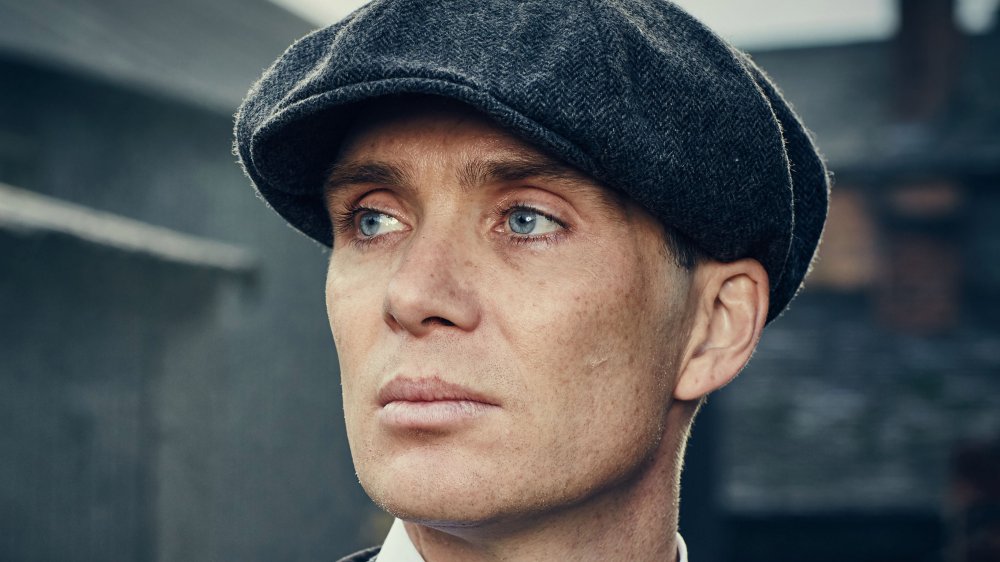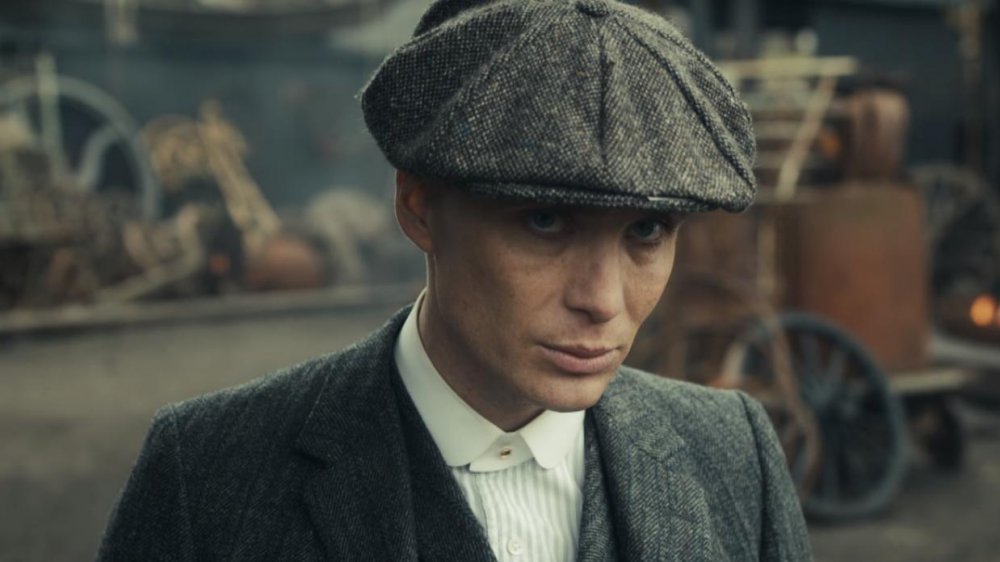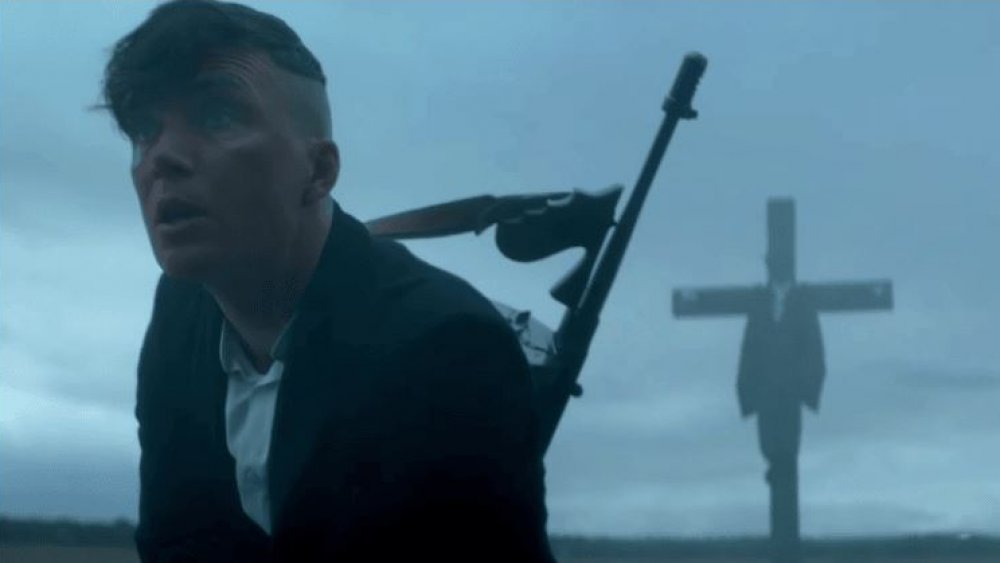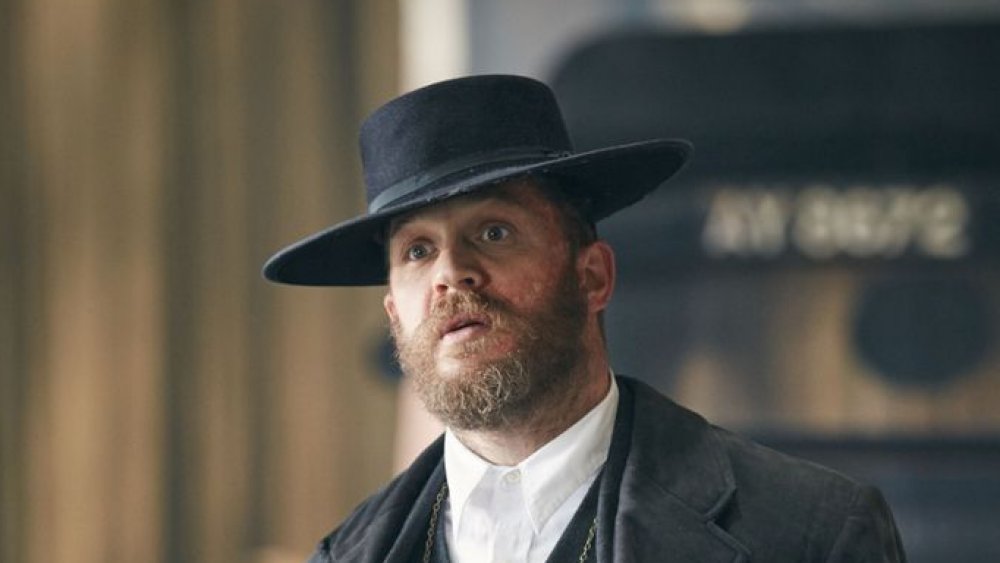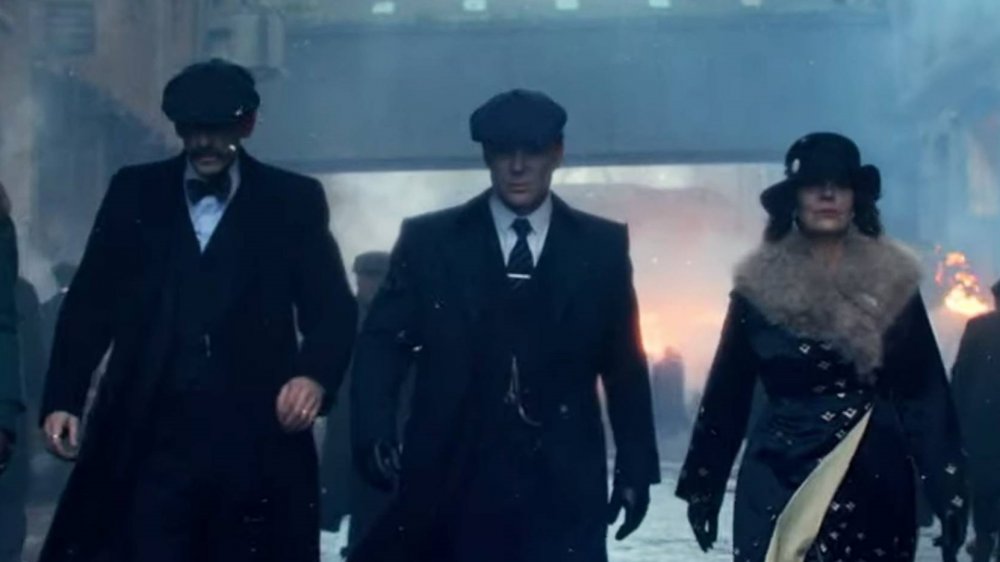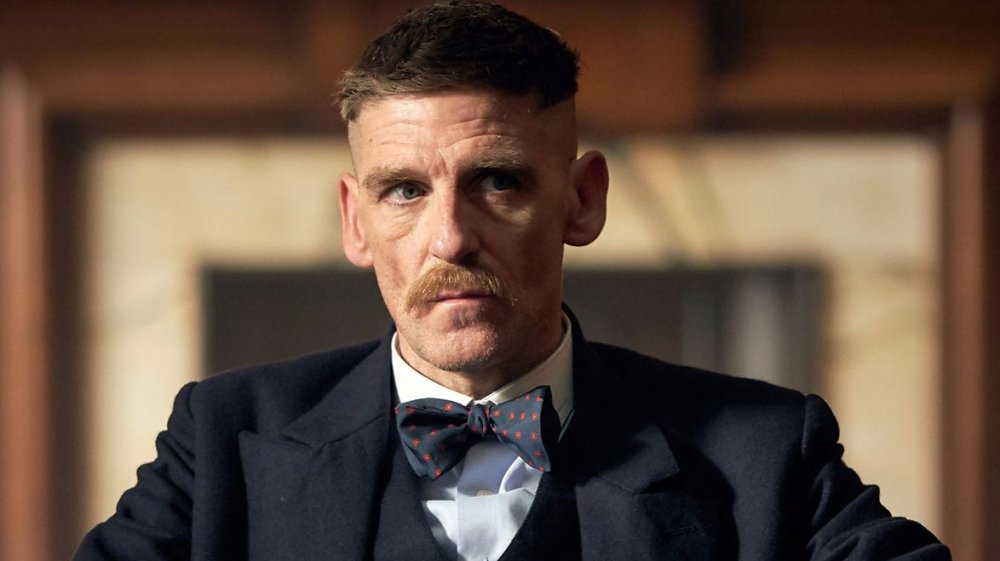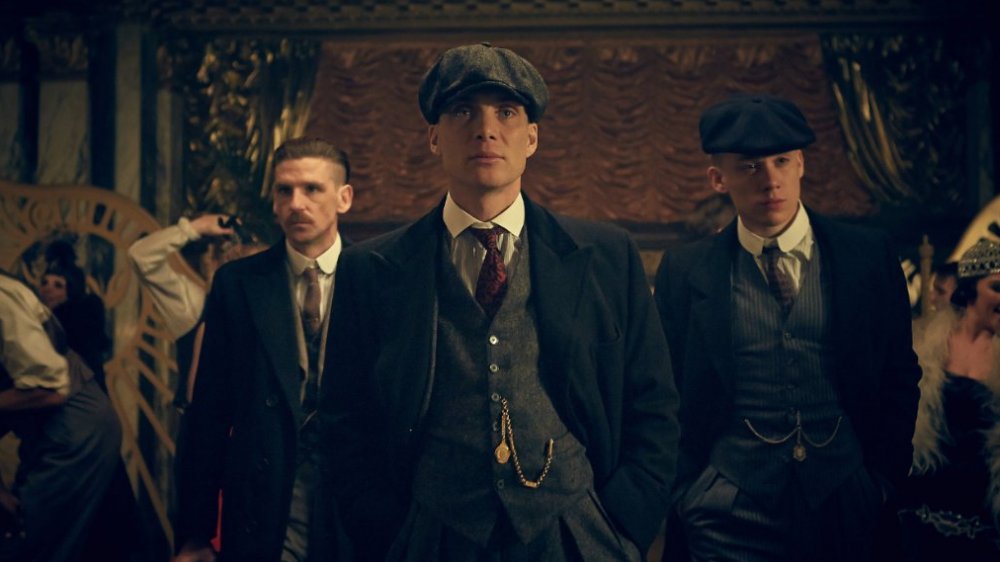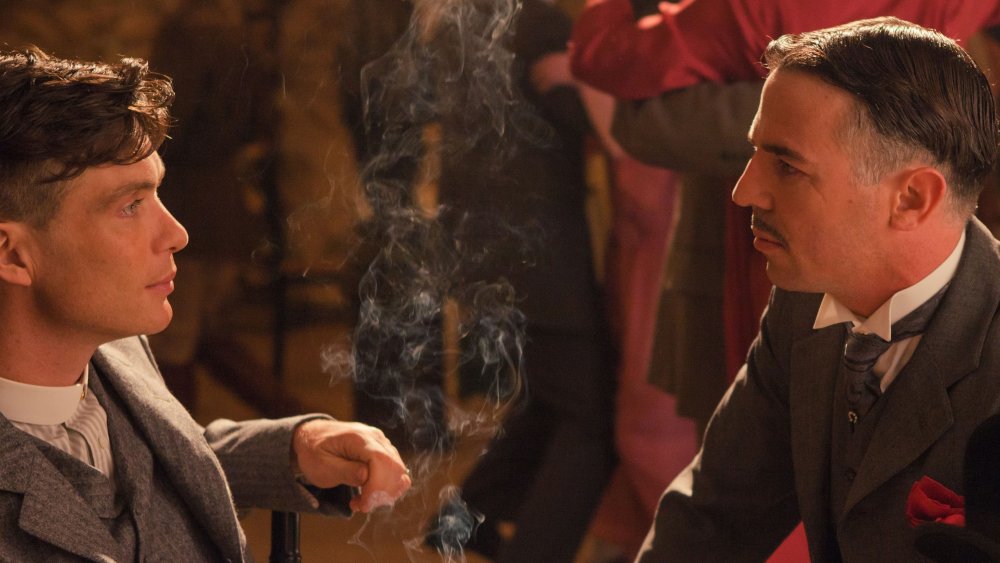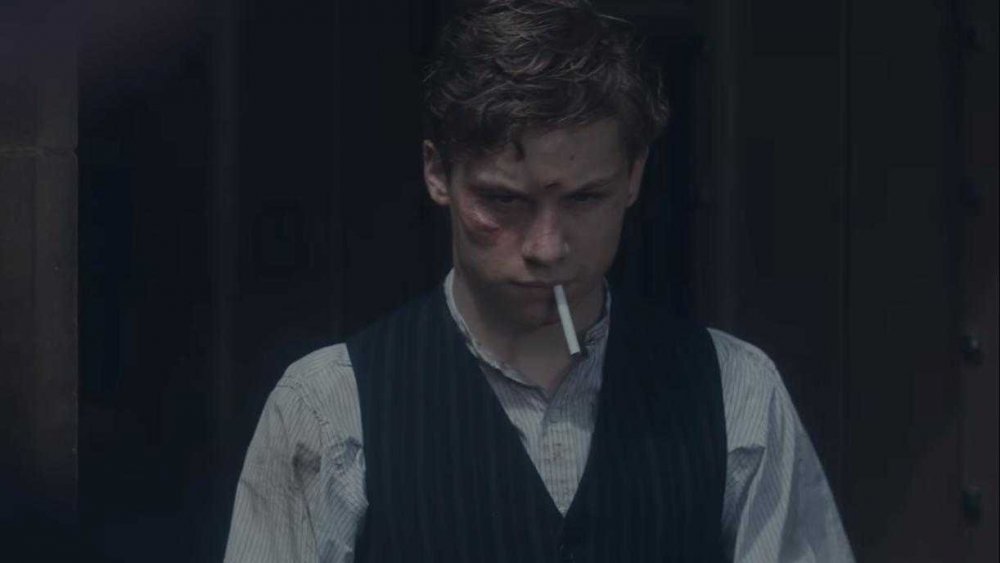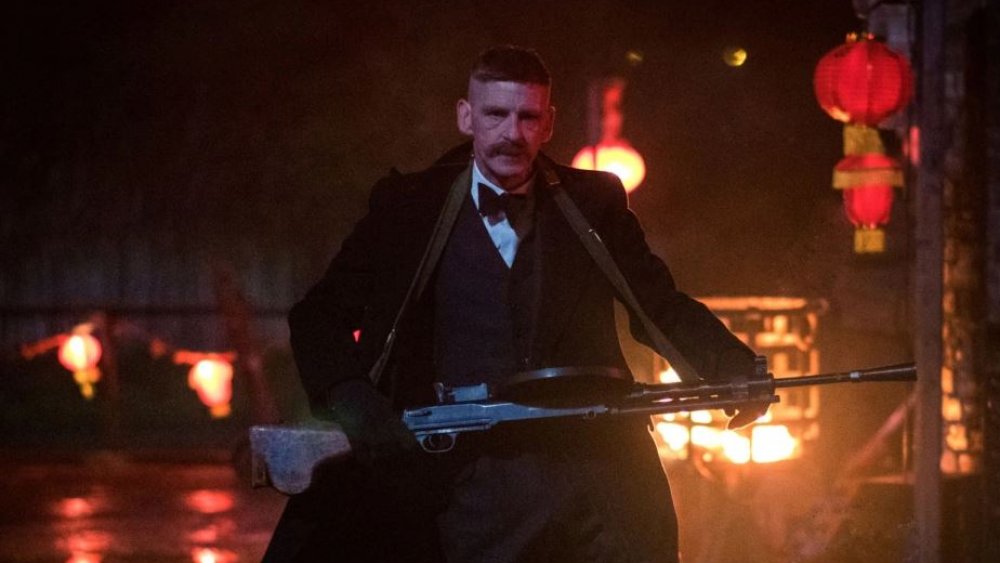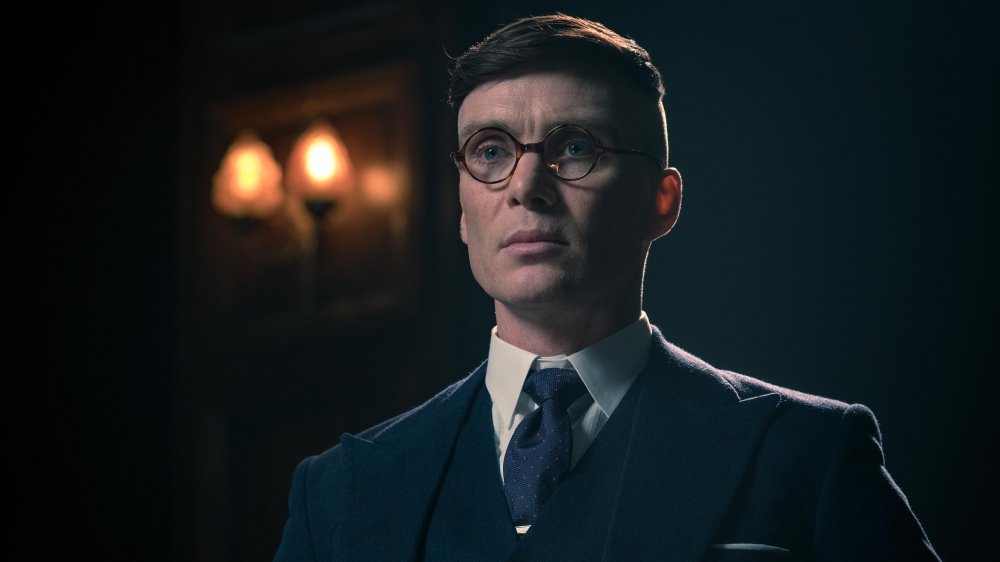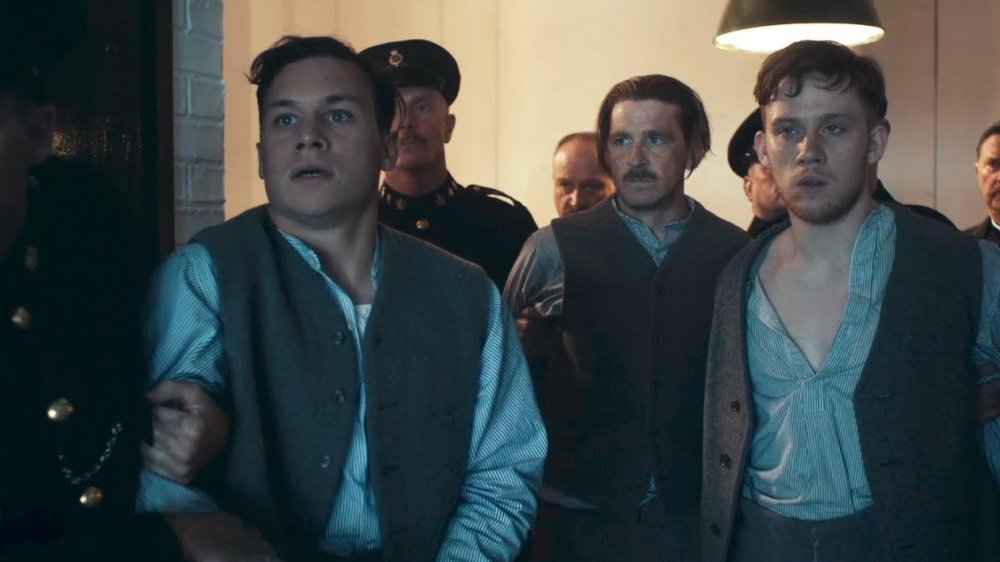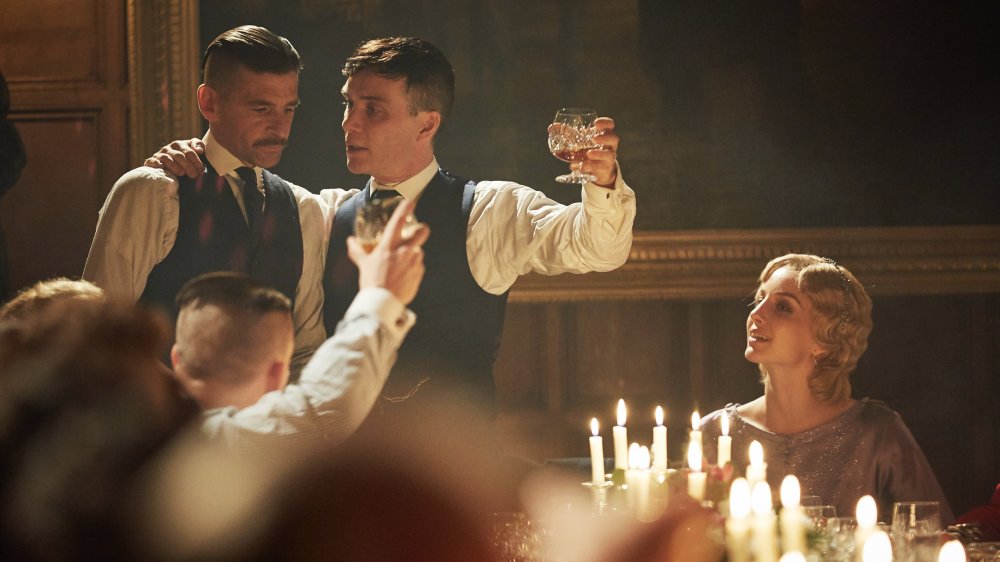How Real Is Peaky Blinders?
The last notes of "Red Right Hand" by Nick Cave & The Bad Seeds die down. An immaculately dressed Tommy Shelby rides a horse through a desolate 1919 Birmingham street, as the residents fled inside in abject terror — only to be treated to a strange fortune-telling scene and a free horse race betting tip from the man. From its very first minutes, it was clear that Peaky Blinders was cut from a different cloth. It seems that a period piece featuring small-time hoods of a relatively little-known English city should have no business attracting esteemed actors like Cillian Murphy, Sam Neill, Tom Hardy, and Adrien Brody. One might even venture to say that it's strange for a show like this to become a pop culture juggernaut that, as BBC tells us, affects everything from fashion to tourism to baby names (apparently, the show's magnificently mustached violent cocaine addict Arthur Shelby is considered a fine namesake for your offspring).
Yet, Peaky Blinders has achieved all that, and continues to run rampant. The thing is, has anyone stopped to ask themselves: How real is this seemingly elaborately constructed slice of history everyone's obsessing over? Is everything in the show accurate, or has the flat cap-wearing populace based its fandom on a cynical lie? Let's find out just how real Peaky Blinders is.
The Peaky Blinders didn't really hide razor blades in their hats
Over the course of the show, the Peaky Blinders gang has used many weapons, from pistols to huge, military-grade machine guns. However, they started the show with one of their most historically famous weapons: Razor blades that they hid in their hat brims, allowing them to slash enemies in the face, filling their eyes with blood and giving the Blinders an upper hand in a fight. Unfortunately, historian Carl Chinn has told the Birmingham Mail that this novel, brutal weapon is almost certainly nothing but a myth. When the real Peaky Blinders roamed Birmingham, razor blades were still a luxury item that was well beyond their financial means, and Screen Rant notes that the weapons they actually used were far more practical than a novelty hat.
Radio Times tells us that according to popular myth, the gang got its name from the bladed, "blinding" peaks of their caps. Unfortunately, since the razor caps most likely didn't exist, this is also inaccurate. The historian Chinn says that the Peaky Blinders probably got their name because they liked to wear peaked caps, and Digital Spy notes that "blinder" was likely just a slang term for their fancy clothing. Still, it's understandable why the show went with the razor blade story. After all, it's far cooler to imply that the Blinders went around wearing James Bond villain hats than to admit that they just liked nice waistcoats.
The time period is all wrong
An important theme in Peaky Blinders is the hidden frailty of its macho, hard-as-nails heroes. The central Shelby siblings, Arthur and Tommy, are both veterans of World War I, and have seen and experienced things that they're still struggling to cope with. Both men have a haunted, hollow look in their eyes, and the showrunners make it extremely clear that Tommy in particular is struggling with a pretty bad case of post-traumatic stress disorder. It's pretty powerful stuff! However, according to Digital Spy, there's just one little problem: The Peaky Blinders weren't WWI veterans.
The real Peaky Blinders gang's heyday was in the 1890s as opposed to the show's 1920s, which means there were precisely zero World Wars to traumatize them. The BBC and Screen Rant report that by the time the events of Peaky Blinders take place, the real Blinders were already a thing of the past. Their main area of operations, Small Heath, had grown larger, and the gang members drifted apart as they grew older and found better things to do with their lives.
Many Peaky Blinders characters are surprisingly real
As Screen Rant tells us, the central Shelby family of Peaky Blinders is entirely fictional, but the world they live in is populated by very real historical figures who constantly interact with the main characters. Take Tom Hardy's larger-than-life Jewish gangster Alfie Solomons, for one. It's easy to think of him as a colorful villain character who was thought up by a screenwriter, but as the JC reports, Solomons did exist and seems to have operated much like he does in the show. However, writer Steven Knight admits that Solomons' exact deeds and personality are "based on legend" due to lack of precise information.
Solomons is not alone, either. Major antagonists Billy Kimber and Darby Sabini were both very real gangsters of the era, as was Season 5's drug kingpin Brilliant Chang, who in real life was a restaurant owner and a powerful criminal known as "dope king." The British fascist politician Oswald Mosley is a real historical person, and there's also some guy named Winston Churchill who might just have a real-life counterpart somewhere in history. Even Charlie Chaplin, a Birmingham native, pops up at one point. However, thanks to the show's liberal attitude towards the time frame of the Peaky Blinders gang itself, many of these famous real characters have been shoehorned in the show in ways they'd never been able to interact with the historical Blinders, who were long gone by the time these people came along.
The Peaky Blinders' costumes
Stylish 1920s fashion is a huge part of Peaky Blinders' appeal, to the point that Esquire has released a guide on dressing like the characters. In an interview with Clothes on Film, costume designer Stephanie Collie reveals the secret to the show's sartorial allure: Staying faithful to the time period, but giving it a slight "Hollywood" twist to make the clothes appealing to the modern viewer's eye and to make things cooler-looking. The main characters' suits are tailored, for one, and Cillian Murphy's Tommy Shelby usually eschews ties with his stiff collar, something a man from his time period wouldn't do. Some things were largely dropped, such as the bell-bottom pants and silk scarfs that the BBC reports the real Blinders had an affinity to. The men's haircuts were inspired by the book Crooks Like Us, which featured photos of Australian convicts.
A thing that is decidedly neither real nor period-accurate are the cigarettes the characters are constantly smoking. As GQ Australia tells us, Cillian Murphy alone has gone through an estimated 5,000 cigarettes over the course of the show. Since smoking is obviously forbidden on set, the "darts" Murphy and his co-stars are habitually holding are actually nice herbal rose cigarettes, and they avoid inhaling the smoke. As Helen McCrory (who plays Polly Gray) jokingly puts it: "No actors were killed in the making of Peaky Blinders."
Peaky Blinders and cocaine
The presence of cocaine, the yuppie drug most closely associated with the 1980s, seems strange in the world of Peaky Blinders. Yet, Arthur Shelby is shoveling truly astounding amounts of the white stuff above his mustache, and as Digital Spy notes, his wife Linda also picks up the habit over the course of the show.
This is more than just a lazy attempt by the writers to add a touch of Scarface in the show's gangsters. As Volteface tells us, cocaine was very much around during WWI, and it would arguably not be unreasonable that Arthur, a former sapper and an implied veteran of many battles from Verdun and the Somme to Gallipoli, would have picked up the habit at some point. Even if he didn't, peace time didn't exactly erase people's taste for the drug, and society at large quite enjoyed it — as evidenced by the era's popular culture, where even Sherlock Holmes himself used cocaine for "intellectual stimulation." There was even a media panic about the drug's prevalence.
The gang that operated like the Peaky Blinders
While the real Peaky Blinders operated before WWI and therefore well before Peaky Blinders takes place, the writers of the show aren't completely anachronistic by placing such a powerful gang in 1920s Birmingham. As Birmingham Mail tells us, there really was a powerful, post-WWI gang in the area, sporting a clear leadership structure and waging war with some of the gangsters the Blinders feud with in the show. In fact, the real gang even mirrors Tommy Shelby's fictionalized operation in that they created a horse racing and betting empire.
So, why didn't they use that gang instead of yanking the Peaky Blinders out of their rightful place in history? According to historian Carl Chinn, it's because the Blinders' name is shrouded in legend and "infused in gangsterdom." Meanwhile, the actual gang making moves in Birmingham after the Great War were called the Brummagem Boys, and later simply the Birmingham Gang, both of which would probably be great names for a middle-aged bowling team. At least, a version of the real-life gang gets a nod on the show as "Birmingham Boys," an early group of antagonists led by Billy Kimber.
Tommy Shelby's real-life counterpart
While Tommy Shelby and his family are decidedly fictional, it could still be argued that the show's central character has a historical counterpart of sorts: Billy Kimber, the sleazy racehorse mogul. As the Birmingham Mail tells us, the real Kimber was actually a rather charismatic Birmingham criminal who was essentially a less traumatized but equally hardcore version of Tommy Shelby. An intelligent, ruthless man and a resourceful fighter, Kimber was a veteran of Birmingham gang life and WWI. After the Great War, he started leading the Birmingham Gang and participating in many shenanigans that were extremely similar to those of the Shelbys. He interacted with some of the Peaky Blinders characters and, like Tommy, ultimately became the biggest gangster in the country. He even eventually took his operations to London and moved to bigger circles himself. Sure, there were some differences. Kimber was a deserter while Tommy Shelby was a war hero, and he didn't become a Member of Parliament like Tommy did, instead starting a new life as a gangster in America and later starting a legitimate racecourse business. Still, there are enough similarities there to raise an eyebrow or two.
As Screen Rant notes, the real Kimber died in 1945, but in Peaky Blinders, Shelby kills him in 1919, which basically allows the Blinders and their fictional leader to take Kimber's place in the era's gangster circles. So, the show even (sort of) acknowledges the fictional Shelby's debt to the real-life Kimber.
Many of the real Peaky Blinders were small children
The gang members in Peaky Blinders are, at least physically, adults who know what they're doing. Much was made of young Michael Gray's introduction to the gang at 17-years-old, and even then he initially stuck to the relative safe task of keeping their accounts in order. However, real Peaky Blinders presumably had little need for bookkeeping, and they recruited members who were much, much younger than you'd expect. According to BBC, the Birmingham gang's more prominent members included David Taylor, 13, and Charles Lambourne, who was just 12-years-old.
Of course, there were also older Peaky Blinders, who obviously wielded more power than the tween section of the gang. Still, the kids were far from mere hangaround members who were just pretending to be gangsters. They got into gang business just like their elders did. For instance, one reason we know about the aforementioned Taylor was that he was arrested and jailed ... for carrying a gun. Rough streets of Birmingham, indeed.
The real Peaky Blinders were not a powerful organization
A central tenet of the Peaky Blinders lore is that the titular gang doesn't just fight hard — it fights smart. The assorted Shelbys and their associates are almost invariably clever, with Cillian Murphy's Tommy and Helen McCrory's Aunt Polly arguably leading the scheming pack. They have both the brawn and the brain power to take on just about anyone, which they also do on a fairly regular basis.
And then there's Arthur Shelby. Tommy's big brother is the most brutal fighter of the Peaky Blinders, but also least likely to come up with a plan that's more complex than "eh, let's just walk all over them." This bombastic attitude has led to some amazingly quotable moments (everybody together now: "This place is under new management ... BY ORDER OF THE PEAKY BLINDERS,") but it took Tommy's guidance to ever get his elder sibling anywhere but an early grave.
As the BBC reports, the real Blinders were basically a gang of Arthurs, minus the ambition. They were ruthless, indiscriminate thugs who targeted pretty much everyone and were mostly legendary because of their physical fighting prowess. While that might have made them interesting as, say, cannon fodder in a Jean-Claude Van Damme movie where the Muscles in Brussels wears a newsboy cap, it's probably safe to say that the introduction of a few ambitious power broker characters has done wonders for the show.
The real Peaky Blinders lacked political ambition
Throughout Peaky Blinders, the Shelby family and Tommy Shelby in particular find themselves playing with increasingly raised stakes. The Blinders have gone from battling fellow crime bosses, mobsters and, er, evil priests to rubbing shoulders with some of the most powerful politicians of the time. It's a pretty standard "rise to power" plot, and since the Shelbys are fictional and unencumbered by the weight of historical fact, the writers have no real reason to stop upping the ante until they jump the shark with "Thomas Shelby, King of the Moon" or whatever.
As the Birmingham Mail tells us, the real Peaky Blinders had no super-resourceful Shelbys to drive their ambition, and as a result, their power level was significantly lower than that of their fictional counterpart. To give an example of the historical Blinders' (lack of) power, just look at who replaced them before World War I even started: The hilariously named Brummagen Gang, a "loose collection of pick-pockets, racecourse thieves, and pests." It was this ragtag group of misfits that went on to morph into a more powerful organization after WWI, but at that point, the Blinders were long gone.
The real Peaky Blinders never did serious time
Many central members of the Peaky Blinders gang are frequently at odds with the law. Apart from their many run-ins with Sam Neill's Inspector Chester Campbell during the first two seasons, several members even receive capital punishment sentences and are due to be executed by hanging (though they're pardoned before the execution can be, uh, executed).
As the Telegraph tells us, the real Blinders were significantly less offensive in the eyes of The Man. In fact, court reports of the era mostly write them off as "foul mouthed young men who stalk the streets in drunken groups, insulting and mugging passers-by," which frankly sounds less "Mafia" and more "Friday night in a dodgy neighborhood." While they reportedly did make some money from running protection rackets, betting and black market stuff, a look at the arrest papers of real, historical Peaky Blinders doesn't exactly make them look like master criminals set to take over the country, Tommy Shelby style.
Actual Blinders such as Harry Fowler, Ernest Bayles, Stephen McHickie, and Thomas Gilbert were arrested from heinous crimes such as breaking and entering, "false pretenses," and ... bicycle theft. As a side note, an episode where Arthur Shelby drunkenly steals a bicycle and spends a day running from a pair of Keystone Cops-style beat officers while desperately trying to fence his loot does sound like a fine hour of television.
The Peaky Blinders were not built around a single family
Peaky Blinders is built around Thomas "Tommy" Shelby and his family, which gives the Blinders an almost mafia-style structure. As Screen Rant tells us, the reality was much different. There was no Shelby-style royal family presiding over the real Peaky Blinders. Instead, the gang was entirely comprised of loosely-knit groups of disillusioned people from the same working class background. There was no "unified code," let alone a single leader.
In fact, Den of Geek reports that Philip Gooderson, the writer of The Gangs of Birmingham, says that the so-called "Peaky Blinders" were not necessarily a gang at all, at least as we understand the term. Gooderson suggests that Peaky Blinders was instead a "rubric name," a generic term used to describe young people who dressed and behaved in a same stereotypical way. That's right, Peaky Blinders were basically a violent, out-of-control version of hipsters — which, in a way, is far more terrifying than the organized crime family portrayed by the show.
